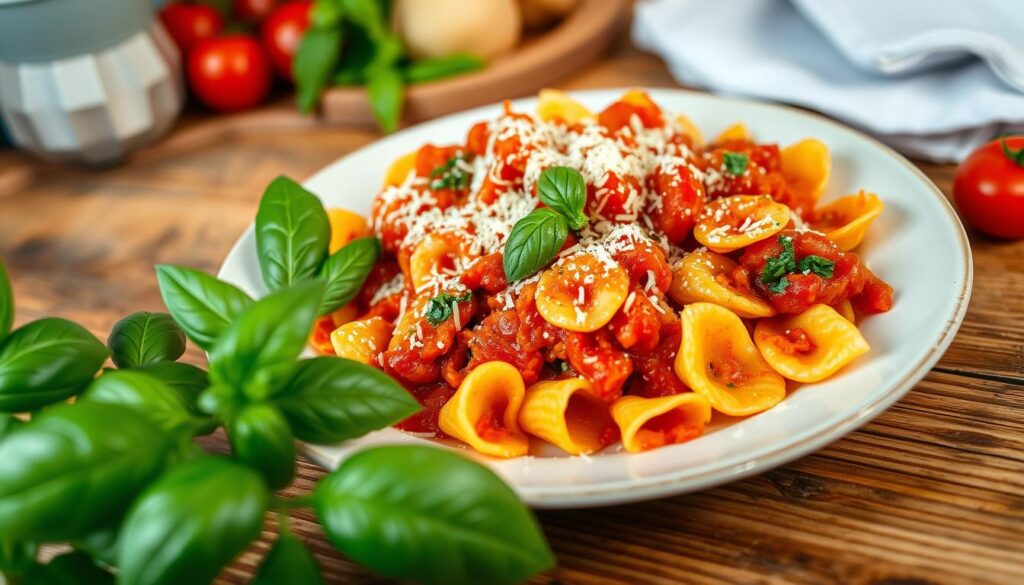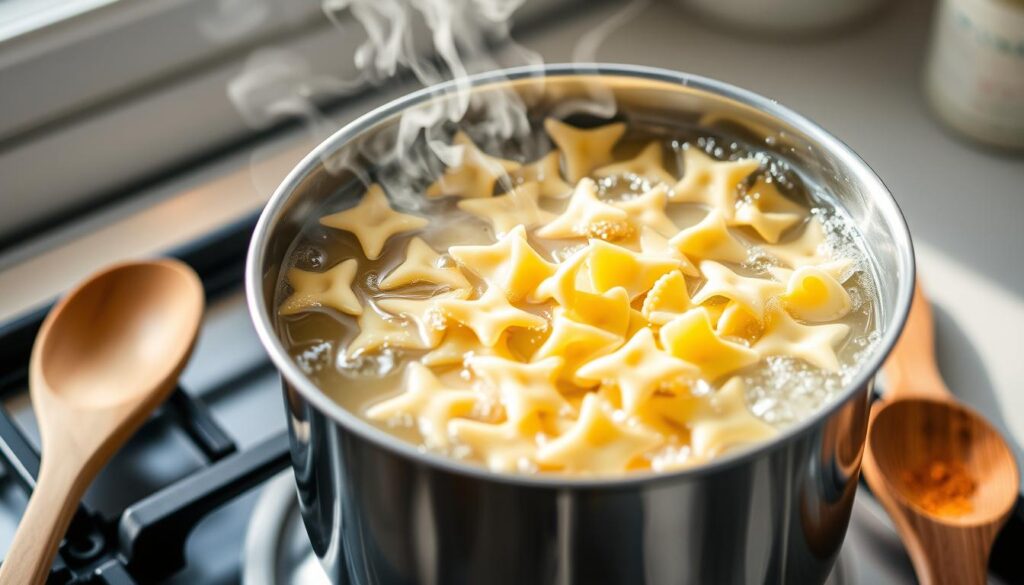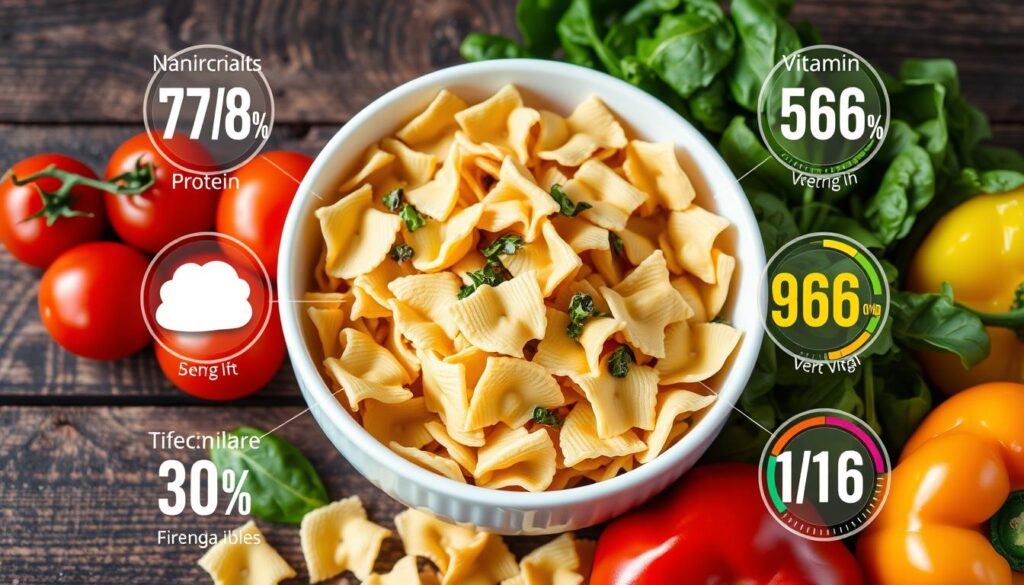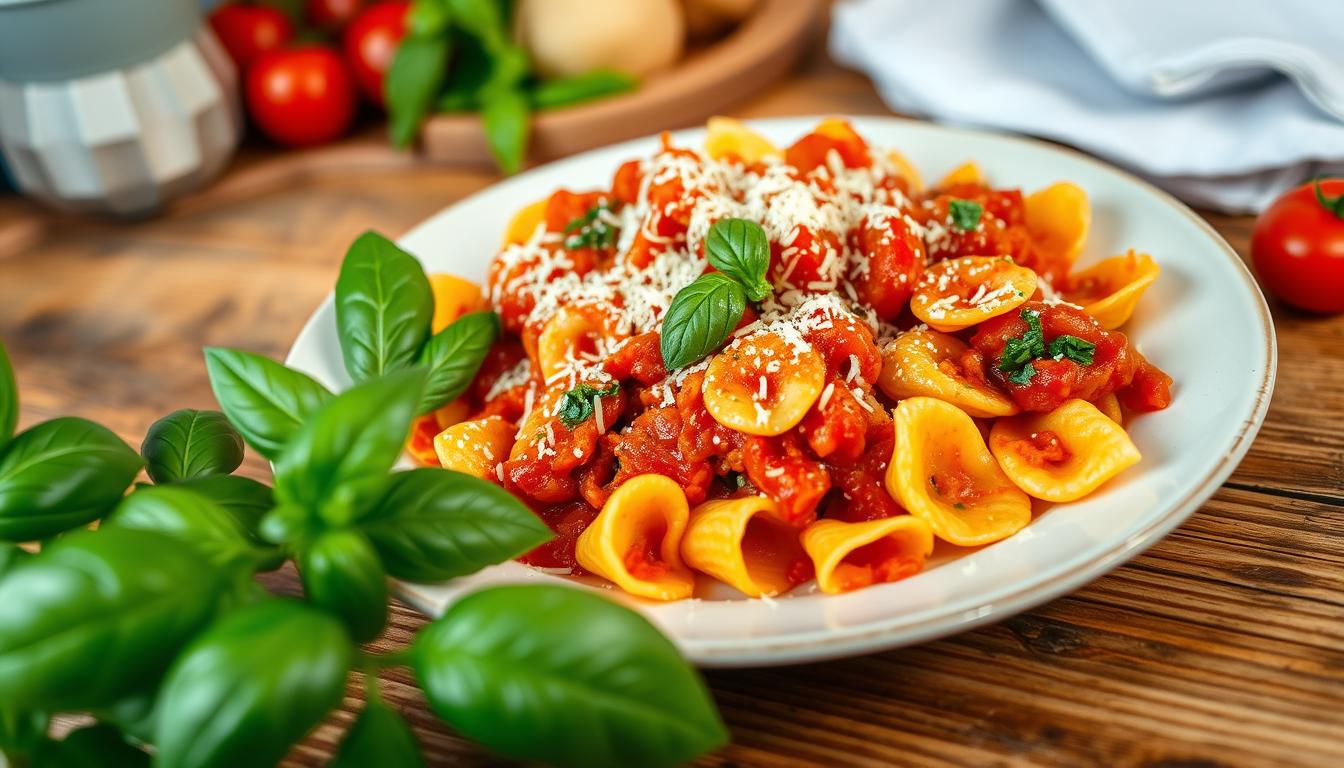Did you know that a single serving of farfalle pasta contains nearly 40% of the daily recommended intake of manganese, a vital mineral that supports bone health and metabolism? This unique, butterfly-shaped Italian staple is not only a delight for the senses but also a nutritional powerhouse that can elevate your meals to new heights.

Key Takeaways
- Farfalle, also known as “bow-tie” or “butterfly” pasta, is a beloved Italian staple.
- The unique shape of farfalle pasta not only makes for a visually appealing presentation but also offers a memorable texture and mouthfeel.
- Farfalle pasta is a versatile ingredient that can be used in a wide variety of dishes, from classic Italian favorites to creative culinary creations.
- This pasta is a nutritional powerhouse, providing a significant amount of essential minerals like manganese, which supports bone health and metabolism.
- Whether you’re a pasta enthusiast or simply looking to add some excitement to your meals, farfalle is sure to capture your heart and taste buds.
What is Farfalle Pasta?
Farfalle, the delightful butterfly-shaped pasta, has a rich history rooted in the culinary traditions of Italy. The name “farfalle” is derived from the Italian word for “butterfly,” a nod to the pasta’s distinctive and whimsical appearance.
Origin and Meaning
The unique design of farfalle features two flat, ribbon-like pieces of dough that are pinched together in the middle, creating the signature bow-tie silhouette. This intricate shaping not only adds visual appeal but also affects the way the pasta cooks and interacts with sauces, making it a beloved choice in Italian cuisine.
Shape and Design
The distinctive shape of farfalle pasta is more than just a pretty face. The unique bow-tie design helps the pasta to better absorb and hold onto the flavors of sauces and seasonings, creating a delightful texture and taste experience with each bite. Additionally, the shape of farfalle allows it to be easily picked up with a fork, making it a popular choice for a wide range of dishes.
Whether you’re enjoying a classic Italian pasta dish or experimenting with new and creative recipes, the captivating shape of farfalle pasta is sure to delight your senses and leave a lasting impression on your palate.
Farfalle: The Versatile Pasta
Farfalle pasta is celebrated for its remarkable versatility, making it a staple in kitchens around the world. Its distinctive shape allows it to hold and capture sauces beautifully, while its firm texture ensures it remains al dente even when cooked. This versatility of farfalle pasta allows it to be used in a wide range of dishes, from classic Italian pasta recipes to creative culinary creations.
Whether you’re whipping up a simple tomato-based dish or experimenting with bold flavors, farfalle is the perfect pasta to bring your culinary vision to life. Its versatility makes it a go-to choice for home cooks and professional chefs alike, who appreciate the uses for farfalle pasta in their diverse culinary endeavors.
From hearty baked casseroles to refreshing summer salads, farfalle pasta shines in a multitude of uses for farfalle pasta. Its distinctive shape and texture allow it to pair perfectly with a wide range of sauces, vegetables, proteins, and seasonings, making it a versatile staple in any well-stocked kitchen.
| Dish Type | Recommended Farfalle Pasta Pairings |
|---|---|
| Pasta Primavera | Farfalle with fresh vegetables, such as asparagus, peas, and cherry tomatoes, in a light, creamy sauce. |
| Baked Farfalle Casserole | Farfalle combined with ground meat, cheese, and a rich tomato-based sauce, then baked to perfection. |
| Farfalle Salad | Chilled farfalle tossed with diced vegetables, fruits, nuts, and a tangy vinaigrette dressing. |
The versatility of farfalle pasta is truly a testament to its enduring popularity and culinary versatility. Whether you’re looking to create a comforting classic or experiment with new flavor combinations, this beloved pasta shape is sure to delight your taste buds and inspire your culinary creativity.
“Farfalle is the perfect pasta for any occasion, from weeknight dinners to special celebrations. Its shape and texture make it a joy to work with in the kitchen.”
Delightful Farfalle Recipes
The versatile and delightful nature of Farfalle pasta opens up a world of culinary possibilities. From classic Italian dishes to creative twists, this delectable pasta can be the star of any meal. Whether you’re in the mood for a comforting classic or an innovative new creation, Farfalle is the perfect canvas for your culinary artistry.
Classic Farfalle Dishes
Farfalle’s ability to complement and enhance traditional flavors is showcased in classic Italian dishes such as Farfalle with Pesto or Farfalle alla Carbonara. These timeless recipes highlight the pasta’s versatility and allow the natural nutty or savory notes to shine.
Creative Twists on Farfalle
Farfalle’s adaptability also allows for exciting new culinary creations. Dishes like Farfalle with Roasted Vegetables or Farfalle in a Creamy Seafood Sauce put a unique spin on this beloved pasta, providing a fresh and flavorful experience for the palate.
“Farfalle is the perfect canvas for your culinary artistry.”
Whether you’re in the mood for a classic or a creative new dish, Farfalle pasta offers a world of delightful possibilities to explore. From comforting favorites to innovative recipes, this versatile pasta is sure to delight your taste buds.
Cooking Tips for Perfect Farfalle
Achieving the perfect al dente texture and mouthwatering flavor with farfalle pasta is a simple yet essential skill. To ensure your farfalle turns out flawlessly, start by bringing a large pot of salted water to a rolling boil. Once the water is at the perfect temperature, gently add the farfalle and stir occasionally to prevent sticking.
Boiling and Seasoning
Cook the pasta until it reaches your desired doneness, typically around 10-12 minutes. Draining the farfalle and tossing it with a bit of olive oil or your favorite sauce immediately after cooking will help the pasta retain its signature shape and texture. Don’t forget to season the boiling water with a generous pinch of salt to enhance the natural flavors of the farfalle.
“The key to perfectly cooked farfalle is paying attention to the water temperature and cooking time. It’s all about finding that sweet spot between tender and al dente.”

Once the farfalle is cooked to your liking, you can further enhance the flavor by tossing it with your favorite seasonings, herbs, or a delicious sauce. Experiment with spices, freshly chopped herbs, or a simple vinaigrette to create a truly mouthwatering pasta dish.
Pairing Farfalle with Sauces and Ingredients
The versatile nature of farfalle pasta extends to its ability to pair beautifully with a diverse range of sauces and ingredients. From the classic comfort of tomato-based sauces to the rich creaminess of alfredo or the herbaceous notes of pesto, farfalle’s unique shape and texture allow it to complement a variety of flavors. Moreover, farfalle pairs exceptionally well with an array of proteins, vegetables, and seasonings, making it a go-to choice for creating satisfying and visually appealing pasta dishes.
When it comes to farfalle pasta sauce pairings, the possibilities are endless. Consider tossing your farfalle with:
- Robust tomato sauce, either classic or with added herbs and spices
- Creamy alfredo or béchamel sauce for a decadent twist
- Vibrant pesto, using basil, arugula, or even sun-dried tomato pesto
- Olive oil-based sauces, like garlic and herb or lemon-caper
The ingredients to pair with farfalle pasta can also be diverse, ranging from simple to sophisticated. Experiment with:
- Grilled or sautéed chicken, shrimp, or Italian sausage
- Roasted vegetables like zucchini, bell peppers, or cherry tomatoes
- Fresh herbs, such as basil, parsley, or oregano
- Grated Parmesan or crumbled feta cheese
- Toasted pine nuts or crunchy breadcrumbs for texture
By exploring the endless possibilities of farfalle pasta sauce pairings and ingredients to pair with farfalle pasta, you can create a multitude of delicious and visually appealing pasta dishes that will delight your taste buds.
| Sauce | Ingredients |
|---|---|
| Tomato Sauce | Grilled chicken, roasted vegetables, fresh basil |
| Alfredo Sauce | Sautéed shrimp, peas, grated Parmesan |
| Pesto | Grilled Italian sausage, cherry tomatoes, toasted pine nuts |
| Olive Oil-based Sauce | Roasted zucchini, fresh parsley, crumbled feta |
“Farfalle pasta is like a canvas, waiting to be transformed by the flavors and textures that you pair with it.”
Nutrition and Health Benefits of Farfalle
When it comes to the nutritional value of farfalle pasta, this delightful butterfly-shaped variety offers a range of benefits. As a type of durum wheat pasta, farfalle is a good source of complex carbohydrates, providing a steady release of energy to fuel your day. Additionally, it contains a moderate amount of protein, making it a satisfying and filling choice for your meals.
Beyond its carbohydrate and protein content, farfalle pasta also boasts a low-fat and low-sodium, making it a healthy option for those looking to maintain a balanced diet. Whether you’re seeking a nutritious base for your meals or simply want to enjoy a delicious and wholesome pasta, farfalle is an excellent choice.
For those interested in optimizing the health benefits of farfalle pasta, opting for whole-wheat or bean-based varieties can further enhance its nutritional profile. These alternative types of farfalle provide additional fiber, vitamins, and minerals, making them a nutritious and satisfying choice for your pasta dishes.
| Nutrient | Amount per 2 oz (57g) serving of Farfalle Pasta |
|---|---|
| Calories | 200 |
| Carbohydrates | 40g |
| Protein | 7g |
| Fiber | 2g |
| Fat | 1g |
| Sodium | 0mg |
By incorporating farfalle pasta into your diet, you can enjoy a delicious and nutritious meal option that supports your overall health and well-being. Whether you’re whipping up a classic Italian dish or exploring creative new recipes, this versatile pasta is sure to delight your taste buds while providing valuable nutrients.

“Pasta can absolutely be a part of a healthy diet, especially when paired with nutrient-dense ingredients like vegetables, lean proteins, and healthy fats.”
The Butterfly Effect: Farfalle in Popular Culture
The whimsical and playful nature of farfalle pasta has captivated the imagination of popular culture. From its appearances in classic Italian films to its use as a visual metaphor in literature and art, this beloved pasta has transcended the culinary world to become a symbol that evokes a sense of joy and creativity.
The distinctive shape of farfalle, often described as resembling a butterfly, has inspired a wide range of creative interpretations. In children’s books and animated films, the pasta’s charming design has been brought to life, enchanting young audiences and sparking their imaginations. Farfalle has become a playful and whimsical ingredient, adding a touch of playfulness to various visual media.
Beyond its visual appeal, farfalle pasta has also found its way into the lexicon of popular culture. References to the pasta’s unique shape and its association with Italy can be found in literature, television, and even music, cementing its status as a beloved and recognizable icon.
This enduring presence of farfalle pasta in popular culture is a testament to its enduring appeal and versatility. From its captivating appearance to its symbolic resonance, this Italian staple has transcended the culinary realm to become a beloved and cherished part of our cultural landscape.
“The butterfly pasta, with its delicate wings, seems to dance on the plate, inviting us to savor its playful charm.”
Buying and Storing Farfalle
When it comes to purchasing and preserving the beloved Farfalle pasta, there are a few key factors to consider. This versatile pasta comes in both fresh and dried varieties, each offering unique benefits. For those seeking the utmost freshness, fresh Farfalle can often be found in the refrigerated sections of specialty grocery stores or Italian markets, providing a delicate and tender texture. On the other hand, dried Farfalle is a more shelf-stable option, readily available in the pasta aisle of most supermarkets.
Fresh vs. Dried Farfalle
When it comes to choosing between fresh and dried Farfalle, the decision often comes down to personal preference and the intended use. Fresh Farfalle is a fantastic choice for dishes where the pasta’s texture is the star of the show, while dried Farfalle excels in heartier, sauced-based recipes. Regardless of the type, proper storage is essential to maintain the quality and freshness of this delightful pasta.
- Where to buy farfalle pasta: Farfalle can be found in the pasta aisle of most grocery stores, as well as specialty Italian markets and online retailers.
- How to store farfalle pasta: Dried Farfalle should be stored in an airtight container in a cool, dry place, while fresh Farfalle should be kept refrigerated and consumed within a few days.
- Fresh farfalle vs dried farfalle: Fresh Farfalle offers a delicate, tender texture, while dried Farfalle is a more shelf-stable option with a firmer bite.
“Proper storage is the key to maintaining the quality and freshness of Farfalle pasta, whether it’s fresh or dried.”
By following these simple guidelines, you can ensure that your Farfalle pasta remains ready to transform your culinary creations, whether you’re creating a classic dish or exploring new and exciting flavor combinations.
Farfalle Variations and Alternatives
While the classic farfalle pasta remains a beloved staple, the culinary world has embraced an array of intriguing variations and alternatives to this iconic butterfly-shaped delight. From regional Italian specialties to globally-inspired shapes, the possibilities for expanding your pasta repertoire are truly endless.
For those seeking a new spin on the traditional farfalle, Italian cuisine offers a wealth of options. Riccioli, a spiral-shaped pasta, and Conchiglie, the iconic shell-shaped variety, are just two examples of the unique takes on the classic butterfly form that have emerged from regional Italian kitchens.
Beyond the borders of Italy, other cultures have also recognized the appealing nature of pasta shapes that mimic the graceful flutter of a butterfly’s wings. Japanese Udon and Chinese Wonton noodles, with their distinct textures and flavors, can serve as captivating alternatives to farfalle, broadening the horizons of pasta enthusiasts.
Whether you’re seeking to explore new culinary adventures or simply want to expand your pasta repertoire, the world of farfalle variations and alternative pasta shapes offers a wealth of possibilities to tantalize your taste buds and ignite your culinary creativity.
| Pasta Variation | Origin | Distinctive Features |
|---|---|---|
| Riccioli | Italy | Spiral-shaped pasta with a unique texture |
| Conchiglie | Italy | Shell-shaped pasta with a concave design |
| Udon | Japan | Thick, chewy noodles made from wheat flour |
| Wonton | China | Delicate and translucent noodles often used in soups |
Ultimately, the world of farfalle pasta variations and alternative pasta shapes offers a wealth of culinary adventures, each with its own unique flavor profile and visual appeal. Whether you’re a passionate pasta enthusiast or simply looking to add some excitement to your meals, exploring these delightful options is sure to expand your culinary horizons.
Conclusion
Farfalle, the captivating butterfly-shaped pasta, has rightfully earned its place as a beloved staple in kitchens around the world. From its origins in Italy to its widespread popularity, this remarkable pasta’s unique design, versatility, and delightful taste have made it a favorite among pasta enthusiasts.
Whether you’re whipping up a classic Italian dish or experimenting with creative new recipes, Farfalle is sure to bring a touch of whimsy and delight to your culinary adventures. From the recap of Farfalle pasta’s journey to the summary of its endless possibilities, this remarkable pasta has captured the hearts and palates of pasta lovers everywhere.
Embrace the charm of Farfalle and discover the endless opportunities it holds for elevating your meals. Revel in the beauty of its butterfly-inspired shape, and let your culinary creativity soar as you explore the endless possibilities of this remarkable pasta.
FAQ
What is the origin and meaning of Farfalle pasta?
Farfalle, also known as “bow-tie” or “butterfly” pasta, has its roots in the rich culinary traditions of Italy. The name “farfalle” is derived from the Italian word for “butterfly,” reflecting the pasta’s distinctive and whimsical shape.
What is the shape and design of Farfalle pasta?
The unique design of Farfalle features two flat, ribbon-like pieces of dough that are pinched together in the middle, creating the signature bow-tie silhouette. This intricate shaping not only adds visual appeal but also affects the way the pasta cooks and interacts with sauces.
How versatile is Farfalle pasta?
Farfalle pasta is celebrated for its remarkable versatility, making it a staple in kitchens around the world. Its distinctive shape allows it to hold and capture sauces beautifully, while its firm texture ensures it remains al dente even when cooked. This versatility allows Farfalle to be used in a wide range of dishes, from classic Italian pasta recipes to creative culinary creations.
What are some classic Farfalle dishes and creative twists on the pasta?
Classic Italian dishes, such as Farfalle with Pesto or Farfalle alla Carbonara, showcase the pasta’s ability to complement and enhance traditional flavors. However, Farfalle’s versatility also allows for creative twists, such as Farfalle with Roasted Vegetables or Farfalle in a Creamy Seafood Sauce.
How do you achieve the perfect al dente texture and flavor with Farfalle pasta?
To ensure your Farfalle turns out flawlessly, start by bringing a large pot of salted water to a boil. Once the water is at a rolling boil, gently add the Farfalle and stir occasionally to prevent sticking. Cook the pasta until it reaches your desired doneness, typically around 10-12 minutes. Draining the pasta and tossing it with a bit of olive oil or sauce immediately after cooking will help the Farfalle retain its signature shape and texture.
What sauces and ingredients pair well with Farfalle pasta?
Farfalle pasta’s versatility extends to its ability to pair beautifully with a wide range of sauces and ingredients. From classic tomato-based sauces to creamy alfredo or pesto, Farfalle’s shape and texture allow it to complement a variety of flavors. Additionally, Farfalle pairs well with a diverse array of proteins, vegetables, and seasonings.
What are the nutritional benefits of Farfalle pasta?
As a type of durum wheat pasta, Farfalle is a good source of complex carbohydrates, providing a steady release of energy. It also contains a moderate amount of protein, making it a satisfying and filling choice. Furthermore, Farfalle is low in fat and sodium, making it a healthy option for those looking to maintain a balanced diet.
How has Farfalle pasta been featured in popular culture?
The whimsical and playful nature of Farfalle pasta has captured the imagination of popular culture. From its appearances in classic Italian films to its use as a visual metaphor in literature and art, Farfalle has become a beloved symbol that transcends the culinary world. The pasta’s distinctive shape has inspired creative interpretations, such as the use of Farfalle in children’s books and animated films.
What are the differences between fresh and dried Farfalle pasta, and how should they be stored?
Farfalle is widely available in both fresh and dried varieties, each with its own unique characteristics. Fresh Farfalle, often found in the refrigerated sections of specialty grocery stores or Italian markets, offers a delicate and tender texture. Dried Farfalle, on the other hand, is a more shelf-stable option that can be found in the pasta aisle of most supermarkets. Regardless of the type, proper storage is essential to maintain the quality and freshness of Farfalle.
What are some variations and alternatives to traditional Farfalle pasta?
While Farfalle remains a beloved and classic pasta shape, there are several variations and alternatives worth exploring. Regional Italian cuisines have given rise to unique takes on the traditional Farfalle, such as Riccioli, a spiral-shaped pasta, or Conchiglie, the iconic shell-shaped variety. Beyond Italy, other cultures have also embraced the appeal of butterfly-like pasta shapes, with Japanese Udon and Chinese Wonton noodles serving as intriguing alternatives.

